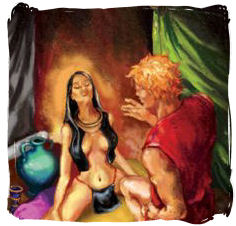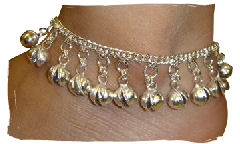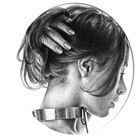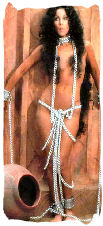Wagon Peoples
Customary Dress
Attire of the Wagon Peoples
Not only because of cultural differences, but regional climates, the clothing of the Wagon Peoples differs in many ways from the garments worn on other parts of the Gor.
The dress of the warrior of the Wagon Peoples is quite spectacular. They carry a small, round, leather shield lacquered with their tribes' colors. They wear a conical, fur-rimmed iron helmet with a net of colored chains to protect their faces, leaving only holes for the eyes (however, the Kataii that meets Tarl at the beginning does not wear the helmet chains). Around their necks, they wear a soft leather wind scarf, so that when the helmet veil is lifted, they can draw the scarf over the mouth and nose to protect against the dust and wind.  They also wear quilted jackets, trimmed with fur and with a fur collar, and under the jacket, a leather jerkin. Their boots are made of hide and also trimmed with fur They wear a wide, five-buckled belt which holds the seven sheaths for the quiva.
They also wear quilted jackets, trimmed with fur and with a fur collar, and under the jacket, a leather jerkin. Their boots are made of hide and also trimmed with fur They wear a wide, five-buckled belt which holds the seven sheaths for the quiva.
And then I saw the first of the outriders, moving toward me, swiftly yet not seeming to hurry. I saw the slender line of his light lance against the sky, strapped across his back. I could see he carried a small, round, leather shield, glossy, black, lacquered; he wore a conical, fur-rimmed iron helmet, a net of colored chains depending from the helmet protecting his face, leaving only holes for the eyes. He wore a quilted jacket and under this a leather jerkin; the jacket was trimmed with fur and had a fur collar; his boots were made of hide and also trimmed with fur; he had a wide, five-buckled belt. I could not see his face because of the net of chain that hung before it. I also noted, about his throat, now lowered, there was a soft leather wind scarf which might, when the helmet veil was lifted be drawn over the mouth and nose, against the wind and dust of his ride. He was very erect in the saddle. His lance remained on his back, but he carried in his right hand the small, powerful horn bow of the Wagon Peoples and attached to his saddle was a lacquered, narrow, rectangular quiver containing as many as forty arrows. On the saddle there also hung, on one side, a coiled rope of braided boskhide and, on the other, a long, three-weighted bola of the sort used in hunting tumits and men; in the saddle itself on the right side, indicating the rider must be right-handed, were the seven sheaths for the almost legendary quivas, the balanced saddleknives of the prairie. — Nomads of Gor, pages 10-11.
The second rider had halted there. He was dressed much as the first man, except that no chain depended from his helmet, but his wind scarf was wrapped about his face. His shield was lacquered yellow, and his bow was yellow. Over his shoulder he, too, carried one of the slender lances. He was a black. Kataii, I said to myself.
The third rider placed himself, reining in suddenly, pulling the mount to its hind legs, and it reared snarling against the bit, and then stood still, its neck straining toward me. I could see the long, triangular tongue in the animal's head, behind the four rows of fangs. The rider, too, wore a wind scarf. His shield was red. The Blood People, the Kassars. I turned and was not surprised to see the fourth rider, motionless on his animal, already in position. The kaiila moves with great rapidity. The fourth rider was dressed in a hood and cape of white fur. He wore a flopping cap of white fur, which did not conceal the conical outlines of the steel beneath it. The leather of his jerkin was black. The buckles on his belt of gold. His lance had a rider hook under the point, with which he might dismount opponents.
About the neck of the fourth rider there was a broad belt of jewels, as wide as my hand. I gathered that this was ostentation. Actually I was later to learn that the jeweled belt is worn to incite envy and accrue enemies; its purpose is to encourage attack, that the owner may try the skill of his weapons, that he need not tire himself seeking for foes. I knew, though, from the belt, though I first misread its purpose, that the owner was of the Paravaci, the Rich People, richest of the wagon dwellers." — Nomads of Gor, page 14.
Now the man facing me lifted his small, lacquered shield and his slender, black lance. "Hear my name," cried he, "I am Kamchak of the Tuchuk!" — Nomads of Gor, page 16."Kutaituchik lifted his head and regarded us; his eyes seemed sleepy; he was bald, save for a black knot of hair that emerged from the back of his shaven skull; he was a broad-backed man, with small legs; his eyes bore the epicanthic fold; his skin was a tinged, yellowish brown; though he was stripped to the waist, there was about his shoulders a rich, ornamented robe of the red bosk, bordered with jewels; about his neck, on a chain decorated with sleen teeth, there hung a golden medallion, bearing the sign of the four bosk horns; he wore furred boots, wide leather trousers, and a red sash, in which was thrust a quiva." — Nomads of Gor, page 43.
Winter Wardrobe: Everyone Looks Alike!
In winter, all Tuchuks, whether slave or Free, wear clothing designed to protect them from the bitter cold of the Plains, such as heavy coats, bosk-hide trousers, furred boots, and caps with ear-flaps that tie under the chin. Of course, kajirae, still must wear their hair unbound. This is often the only visible sign of their slave status during the winter months. Some slave girls also wear their Turian collars outside of their coats, beneath the furred collar. The male slaves are shackled at the ankles, with approximately a foot of the chain a visible reminder to all that they are captives.
"The Wintering was not unpleasant, although, even so far north, the days and nights were often quite chilly; the Wagon Peoples and their slaves as well, wore boskhide and furs during this time; both male and female, slave or free, wore furred boots and trousers, coats and the flopping, ear-flapped caps that tied under the chin; in this time there was often no way to mark the distinction between the free woman and the slave girl, save that the hair of the latter must needs be unbound; in some cases, of course, the Turian collar was visible, if worn on the outside of the coat, usually under the furred collar; the men, too, free and slave, were dressed similarly, save that the Kajiri, or he-slaves, wore shackles, usually with a run of about a foot of chain. " — Nomads of Gor, page 59.
Attire of the Free Woman
Free women of the Wagon Peoples do not wear veils or the heavy Robes of Concealment. They wear long dresses made from the tanned skin of the bosk and wear their hair in braids.
At last she had finished the garment, and Kamchak unchained her that she might rise and put it on. Not surprisingly, but to my amusement, I noted that it hung several inches below her knees, indeed, only about four inches or so above her ankles. Kamchak took one look and, with a quiva, shortened it considerably, indeed, until it hung even more briefly than had the quite short, delightful yellow shift in which she had been captured. "But it was the length of the leather dresses of the Tuchuk women," Elizabeth had dared to protest.
"But you are a slave," said Kamchak. — Nomads of Gor, page 64.
Accourtements for Women — Slave and Free
Customary amongst the Tuchuk, all free women and slaves wear a small nose ring, wear a thin gold ring in the nose, just as do the bosk. The ring is delicate, and catches the light when the woman moves, adding greatly to her beauty. The Tuchuk nose ring on a slave girl increases her value on the market as well. It is not mentioned as to whether or not the other Wagon Peoples practice the same. Barbaric as the nose rings may seem, the Tuchuks, and most Goreans for that matter, consider earrings a much more barbaric practice.
"I supposed that on the morrow Kamchak would call for the Tuchuk Iron Master, to brand what he called his little barbarian… following the branding, I supposed that Kamchak would have one of the tiny nose rings affixed; all Tuchuk females, slave or free, wear such rings…" — Nomads of Gor, page 62.
"Tuchuks," I remarked, "regard the piercing of ears as a barbarous custom inflicted on their slave girls by Turians." Elizabeth looked up, the tiny ring glinting in the light of the fire bowl.
"Are your ears pierced?" I asked.
"No," she said, "but many of my friends on Earth who owned fine earrings, had their ears pierced."
"Did that seem so dreadful to you?" I asked.
"No," she said, smiling.
"It would to Tuchuks," I said. "They do not even inflict that on their Turian slaves." I added, "And it is one of the great fears of a Tuchuk girl that, should she fall into Turian hands, it will be done to her." — Nomads of Gor, page 281.
Clad Kajir
To be  clad kajir for the slave girls of the Tuchuk, is to wear four articles, two red and two black. First, a red cord, the curla, is tied about the waist; the chatka, a long, narrow strip of black leather fits over the cord in front, passes under, and then again, from the inside, passes over the cord in back and drawn tight; the kalmak is then donned, a short, open, sleeveless vest of black leather; then lastly, the koora, a strip of red leather matching the curla is wound about the head, to hold the hair back for slave women of the Wagon People are not allowed to braid their hair, or otherwise dress their hair in any other way other than the koora. Of course, whether a girl wears something — or nothing — is, as always, at the whim and desires of the masters.
clad kajir for the slave girls of the Tuchuk, is to wear four articles, two red and two black. First, a red cord, the curla, is tied about the waist; the chatka, a long, narrow strip of black leather fits over the cord in front, passes under, and then again, from the inside, passes over the cord in back and drawn tight; the kalmak is then donned, a short, open, sleeveless vest of black leather; then lastly, the koora, a strip of red leather matching the curla is wound about the head, to hold the hair back for slave women of the Wagon People are not allowed to braid their hair, or otherwise dress their hair in any other way other than the koora. Of course, whether a girl wears something — or nothing — is, as always, at the whim and desires of the masters.
"Among the Wagon Peoples, to be clad Kajir means, for a girl, to wear four articles, two red, two black; a red cord, the Curla, is tied about the waist; the Chatka, or long, narrow strip of black leather, fits over this cord in the front, passes under, and then again, from the inside, passes over the cord in the back; the Chatka is drawn tight; the Kalmak is then donned; it is a short, open, sleeveless vest of black leather; lastly the Koora, a strip of red cloth, matching the Curia, is wound about the head, to hold the hair back, for slave women, among the Wagon Peoples, are not permitted to braid, or otherwise dress their hair; it must be, save for the Koora, worn loose." — Nomads of Gor, page 30.
The girl lifted her head. "Is a Tuchuk too poor," she asked, "to clothe a miserable slave?'"
"I have many diamonds in the wagon," said Kamchak, "which you may wear if you wish — but nothing else will you wear until it pleases me." — Nomads of Gor, pages 135-136.
Girls, of course, often beg to wear a bit of clothing. And, of course, even though of the Wagon Peoples, a slave girl may not necessarily be given the chatka and curla to don, but rather, a simple camisk.
"Well," said Kamchak, "what is it that a Turian wench would crave of her master?"
"Nothing," said Aphris.
"If you do not ask him, I shall," said Elizabeth.
"Speak, Slave!" shouted Kamchak and Aphris went white and shook her head.
"She found something today," said Elizabeth, "that someone had thrown away."
"Bring it!" said Kamchak.
Timidly Aphris rose and went to the thin rep-cloth blanket that was her bedding near the boots of Kamchak. Hidden in the blanket there was a faded yellow piece of cloth, which she had folded very small. She brought it to Kamchak and held it out to him. He took it and whipped it out. If was a worn, stained Turian camisk, doubtless one that had been worn by one of the Turian maidens acquired in Love War. Aphris had her head to the rug, trembling. When she looked up at Kamchak there were tears in her eyes. She said, very softly, "Aphris of Turia, the slave girl, begs her master that she might clothe herself."
"Aphris of Turia," laughed Kamchak, "begs to be permitted to wear a camisk"
The girl nodded and swiftly put her head down.
"Come here, Little Aphris," said Kamchak.
She came forward.
He put his hands in the strings of diamonds on her throat. "Would you rather wear diamonds or the camisk?" he asked.
"Please, Master," she said, "the camisk."
Kamchak jerked the diamonds from her collar and threw them to the side of the room. Then he withdrew from his pouch the key to her collar and bells and, lock by lock, removed them from her. She could hardly believe her eyes. "You were very noisy," Kamchak said to her, sternly.
"A slave girl is grateful to her master," said Aphris, tears in her eyes.
"Properly so," agreed Kamchak.
Then, delighted, Aphris, assisted by Elizabeth Cardwell, donned the yellow camisk. Against her dark almond eyes and long black hair the yellow camisk was exceedingly lovely.
"Come here," commanded Kamchak, and Aphris ran lightly to him, timidly. "I will show you how to wear a camisk," said Kamchak, taking the cord and adjusting it with two or three pulls and jerks that just about took the wind out of the Turian girl. He then tied it tightly about her waist. "There," he said, "that is how a camisk is worn." — Nomads of Gor, pages 151-152.
Even the slave girl of the Wagon Peoples enjoys the chance to wear the slinky silks.
"She laughed happily and turned, and standing on her tiptoes, lowered the tharlarion oil lamps. Then she bent to find for herself among the riches of the wagon yellow Pleasure Silks." — Nomads of Gor, page 298.
The wild, fierce girls of the wagon peoples, so beautiful in their own right, it is understandable why others on Gor would have their girls dress similarly.
"The red cord, or Curla, was knotted about my waist, tightly, the knot, a slip knot which might be loosened with a single tug, over my left hip." — Slave Girl of Gor, page 328.
"Over the Curla in front, slipping under the body and between the legs, and passing over the Curla in the back, was the Chatka, or narrow strip of black leather, some six inches in width, some five feet or so in length; it was drawn tight; when a girl wears the Curla and Chatka, the brand, whether on left or right thigh, is fully visible, for the inspection of masters." — Slave Girl of Gor, pages 328-329.
"I also wore a brief, open, sleeveless vest of black leather, the Kalmak…" — Slave Girl of Gor, page 329.
"… I wore a broad Koora, which, kerchieflike, covered most of my head." — Slave Girl of Gor, page 329.
A cloth version of the chatka and curla is sometimes found worn by girls in the cities.
"A string was knotted about her waist. Over this string, in the front, there was thrust a single, simple narrow rectangle of vulgar, white rep-cloth, some six inches in width, some twelve inches in length." — Beasts of Gor, page 79.
The Attire of the Kajirus
The male slaves of the Tuchuks (kajiri) are generally captives from Turia, the great city on the plains. For a male slave to be clad kajir, they wear the kes, a short sleeveless tunic of black leather.
"For a male slave, or Kajirus, of the Wagon Peoples, and there are few, save for the work chains, to be clad Kajir means to wear the Kes, a short, sleeveless work tunic of black leather." — Nomads of Gor, page 30.
Ankle Bells
Bells on a slave's ankles — Beautiful? Sensual?  It is often seen in wagon camps of the virtual world, slaves happily displaying bells on their ankles and wrists. While in the cities, bells are used as adornments, among the wagon peoples, bells are solely used to designate a slave who is not to be trusted. Should a girl be mistrusted by her master, she may be stripped of all garments, so that she cannot hide a weapon on her person, and also may be belled at her wrists and ankles so that her movements can be easily kept track of.
It is often seen in wagon camps of the virtual world, slaves happily displaying bells on their ankles and wrists. While in the cities, bells are used as adornments, among the wagon peoples, bells are solely used to designate a slave who is not to be trusted. Should a girl be mistrusted by her master, she may be stripped of all garments, so that she cannot hide a weapon on her person, and also may be belled at her wrists and ankles so that her movements can be easily kept track of.
"After all, it is difficult to sneak up on a man while wearing collar and bells." — Nomads of Gor, page 155.
Collars
Tuchuk slaves generally wear the Turian collar, which is a round ring that fits very loosely around the neck. When the collar is grasped in a Master's fist, the slave can turn around in it. The collar is engraved with identifying marks, so that the slave can be returned to the proper Master if he or she attempts an escape.
When the collar is grasped in a Master's fist, the slave can turn around in it. The collar is engraved with identifying marks, so that the slave can be returned to the proper Master if he or she attempts an escape.
"…after these things there would only remain, of course, an engraved Turian collar and the clothing of Elizabeth Cardwell Kajir. — Nomads of Gor, page 62.
"She could speak Gorean but she could not read it. For that matter many Tuchuks could not, and the engraving on the collars of their slaves was often no more than a sign which was known to be theirs. Even those who could read, or pretended to be able to, would affix their sign on the collar as well as their name, so that others who could not read could know to whom the slave belonged. Kamchak's sign was the four bosk horns and two quivas." — Nomads of Gor, page 279.
Chains and etc.
Even the Wagon Peoples make use of such bindings which make a girl that much more beautiful, such as the sirik.
Peoples make use of such bindings which make a girl that much more beautiful, such as the sirik.
"She wore the Sirik and was, of course, clad Kajir, clad in the Curla and Chatka, the red cord and the narrow strip of black leather; in the Kalmak, the brief vest, open and sleeveless, of black leather, and in the Koora, the strip of red cloth that bound back her brown hair. About her throat was the Turian collar with it chain, attached to slave bracelets and ankle rings, one of the latter attached to the chain running to the slave ring. I saw that her left thigh, small and deep, bore the brand of the four bosk horns. — Nomads of Gor, page 282.
![]()
Special Note
Because of the differences in publishing the books, depending upon whether published in the U.S. or Europe, depending upon whether a first publishing or a Masquerade Books release, page numbers will often vary. All of my quotes are from original, first-printing U.S. publications (see The Books page for a listing of publishers and dates) with the exception of the following books:
- Tarnsman of Gor (2nd Printing, Balantine)
- Outlaw of Gor (11th Printing, Balantine)
- Priest-Kings of Gor (2nd Printing, Balantine)
- Assassin of Gor (10th Printing, Balantine)
- Raiders of Gor (15th Printing, Balantine)
- Captive of Gor (3rd Printing, Balantine)
Disclaimer
These pages are not written for any specific home, but rather as informational pages for those not able to get ahold of the books and read them yourself. Opinions and commentaries are strictly my own personal views, therefore, if you don't like what you are reading — then don't. The information in these pages is realistic to what is found within the books. Many sites have added information, assuming the existences of certain products and practices, such as willowbark and agrimony for healing, and travel to earth and back for the collection of goods. I've explored the books, the flora, the fauna, and the beasts, and have compiled from those mentioned, the probabilities of certain practices, and what vegetation mentioned in the books is suitable for healing purposes, as well as given practicalities to other sorts of roleplaying assumptions.